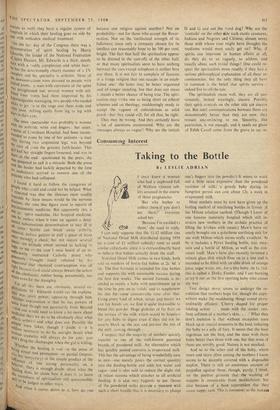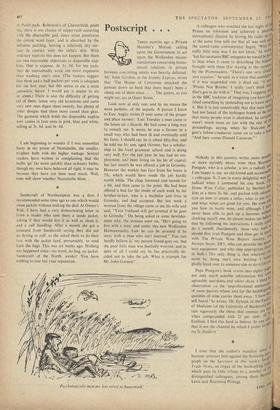Consuming Interest
Taking to the Bottle
By LESLIE ADRIAN I orsaft: 'knew a woman ■ %ho had a cupboard full of Welfare vitamin tab- lets amassed in the course of three pregnancies.
46:ct them,' she used to reply.
'But why bother to collect them. if you don't eat them'?' everyone asked her.
'Because I'm entitled to I Lan only suppose that the 11.42 million tins of National Dried Milk distributed during 1959 tat a cost of million subsidy) went to swell similar collecl,oiis. since it is extraordinarily hard to believe th it babies actually drink the stuff.
National Dried Milk comes in two kinds, both sold to mothcrs of bottle-fed babies at 2s. 4d. a tin. The first fcrmula is intended for tiny babies and supports life with reasonable success during the first few weeks. The second formula is in- tended to supply a baby with nourishment up to the time he gets on to 'solids' and to supplement his diet for some considerable time after that. Using every kind of whisk, mixer and beater we can lay hands on. we find it quite impossible to blend this pm, der. Huge globules of fat float on the surface of the milk which would be hopeless for any baby to digest even if they did not in- stantly block up the teat and prevent the rest of the milk coming through.
I suspect that the majority of mothers quickly transfer to one of the well-known patented brands of powdered' milk. An alternative which has quickly gained converts is evaporated milk. This has the advantage of being wonderfully easy to mix—one merely pours the correct quantity into the feeding-bottle and adds hot water and sugar-2nd is also said to reduce the slight risk of infant eczema which attaches to all artificial feeding. It is also very hygienic to use. (Some of the powdered milks provide a measure with such a short handle that it is necessary to plunge one's fingers into the powder.) It seems to work out a little more expensive than the powdered varieties of milk; a greedy baby during its hungriest period can cost about 12s. a week in evaporated milk.
Most mothers must by now have given up the boiling method of sterilising bottles in favour of the Milton solution method. (Though 1 know of one famous maternity hospital which still in- structs new mothers in the archaic practice of filling the kitchen with steam.) Maw's have re- cently brought out a polythene sterilising unit for use with Milton which seems really excellent. At 9s. it includes a Pyrex feeding bottle, teat, mea- sure and a bottle of Milton, as well as the con- tainer itself. Maw's have also recently invented a minute glass dish which fixes on to a teat and is intended to be filled with an elfin drink of orange juice, sugar water, etc., for a tiny baby. At Is. lid. this is called a Dinky Feeder, and I am burning to try it out on the first sporting baby who comes my way.
Teat design never seems to undergo the re- volution that mothers hope for, though the copy- writers make the maddening things sound extra- ordinarily efficient. 'Cherry shaped for proper
feeding action . made with the tender, resi- lient softness of a mother's skin. . . .9 What they 'don't mention is that without exception teats block up at crucial moments in the feed, reducing the baby to a jelly of fury. It seems that the least ingenious are the best, and the ones with three holes better than those with one, but that none of them are. terribly good. Nature is not mocked,
And so to the other end of the baby, which more and more often among the mothers I know seems to be decently covered with a disposable napkin. There is still an enormous amount of prejudice against these, though, partly, I think. on the puritan grounds that the washing of nappies is inseparable from motherhood; but also because of a base superstition that they cause nappy rash. This is nonsense: as the makers
of Paddi-pads, Robinson's of Chesterfield, point put, there is less chance of nappy-rash occurring with the disposable pad, since urine penetrates lhe cotton wool layer, and is absorbed by the cellulose padding, leaving a relatively dry sur- face in contact with the child's skin. With ordinary napkins this does not happen. But there are two reasonable objections to disposable nap- kins. One is expense. At is. 9d. for ten pads, they do undoubtedly work out more expensive than washing one's own. (The makers suggest that three and a half packets per week is adequate for the first year, but this seems to me a most optimistic figure. 1 would put it nearer to six or seven.) There is also the difficulty of getting rid of them. Some very old lavatories and some very new ones digest them sweetly, but plenty of other designs find them more camel than gnat. The garment which holds the disposable napkin now comes in four sizes in pink, blue and white, selling at 5s. 6d. and 6s. 6d.
I am beginning to wonder if I was somewhat hasty in my praise of Neatabulbs, the smaller, brighter bulb with the higher wattage. Several readers have written in complaining that the bulbs `go' far more quickly than ordinary bulbs; though my own have behaved all right, it may be because they have not been used much. Well, time will show whether Neatabulbs blow.
*
Suedecraft of Northampton was a firm I recommended some time ago as one which would clean jackets without making the deal At Owner's Risk. I have had a very disheartening letter in from a reader who sent them a suede jacket, asking if they would dye it as well as clean it, and a calf handbag. After a month she got a postcard from Suedecraft saying they did not uo dyeing or calf: so she asked them to do their hest with the jacket (and, presumably, to send back the bag). This was six weeks ago. Nothing nas happened since—no word, no bag, no jacket. Suedecraft of the North, awake! You have nothing to lose but your reputation.















































 Previous page
Previous page